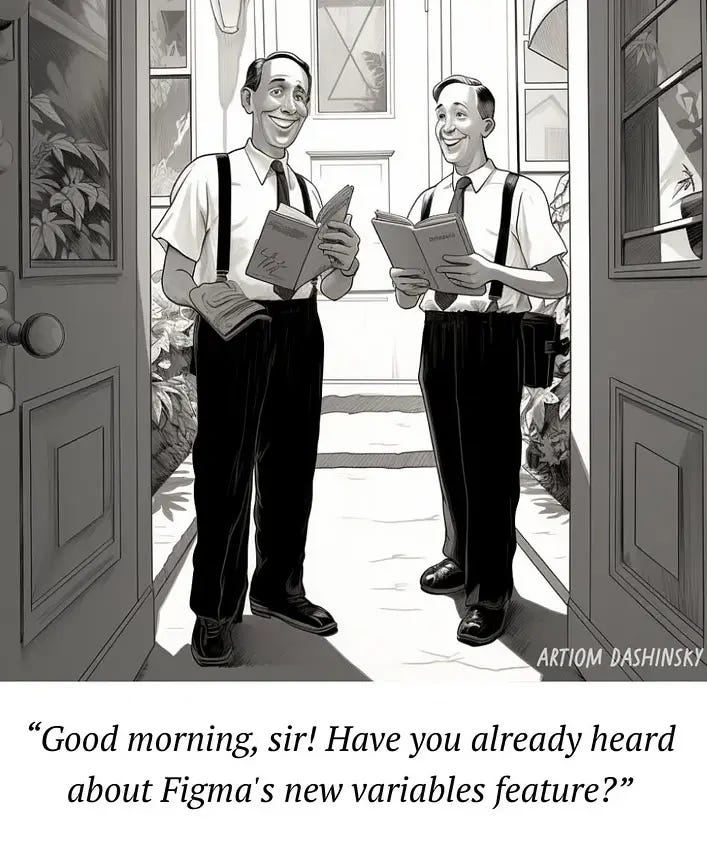Issue 71
The constant tension between "popping" designs
Hello, dear readers! 👋
In this issue, among other things:
How to improve transition animations in interfaces
How to find a balance between the development of hard and soft skills
What is the danger of data-driven thinking
Three ways to create design tokens in Figma
19 practical recommendations for improving the interface
A selection of tips that will allow you to recognize images created by AI
What is framing, how ethical is it and what is its benefit
Why you need to give up reading the news
14,700 posters in the online gallery of the London Museum of Transport
…and much more!
Enjoy reading!
🗞 News and articles
Transition animations: a practical guide
Dongkyu Lee wrote about the role of transition animation in interfaces, and also described in detail and showed 6 recommendations that will help make animations better.
The secret formula for Apple’s rounded corners
Arun Venkatesan spoke about the theory of Naoto Fukasawa, according to which the rounding of the shapes of an object depends on how close it should be to a person. For example, a clock has very rounded shapes, and a cabinet located at a distance is angular.
Arun also measured the degree of rounding in most Apple products and found that they apply this principle.
The constant tension between design tools and soft skills
Shumroze Bhat reflects on how to find a balance between learning tools and developing soft skills. He watched the discussion about this in the design community and decided to express his own thoughts.
The article also has a couple of tips on how designers can build their development strategy.
Main thoughts:
If you are a novice designer, then first focus on learning typography, color, composition, and other design basics. Also take the time to study standard tools such as Figma
When you gain experience and move to middle or senior level positions, your need for soft skills will increase dramatically. You will have to present your work more often, collect feedback or organize the work of other designers
If you are working on a complex design system, then it makes sense to delve into the advanced functions of tools such as Figma
If you work in an agency, then most likely the speed of work is important for you. In this case, it makes no sense to dive too deeply into new and complex functions of the tools
The main principle: focus on those skills that are most valuable and relevant to your position and career goals
The «data-driven» mindset feeds our dangerous craving for certainty
Kyle Byrd explained the dangers of data-driven thinking and why people have an obsessive desire to feel confident in their decisions.
Instead of constantly trying to find the truth and confirm it with data, he suggests asking bold questions, provoking discussions and acknowledging uncertainty, and questioning the data. As a result of this approach, the focus should be on goals and solutions, after which it is already possible to conduct research.
Kyle also explained how the focus on data serves confirmation bias and why people have a craving to justify already existing beliefs. As an example, he cited a number of cognitive distortions that lead us to the illusion of confidence.
Data is an ingredient, not the truth — it must be interrogated — but our desire to feel certain is stronger than any desire for understanding.
⚡️ Briefly
Interface quality of life improvements. Anthony Hobday has published 19 practical recommendations that will improve the usability of the interface.
Framing Effect: Why context affects decisions. Growth Design wrote about framing, as well as its ethics and benefits for business. This technique involves the use of advantageous formulations and psychological tricks that form a positive perception of the user or encourage him to take the necessary actions.
Getting your head around Figma Variables, Figma Styles and Tokens Studio. Louis Chenais wrote about styles and variables in Figma, as well as about the Tokens Studio plugin (formerly Figma Tokens). He briefly compared these three tools within the framework of creating a design token system, and also talked about their limitations and how to use them together.
Keep reading with a 7-day free trial
Subscribe to bezier.design to keep reading this post and get 7 days of free access to the full post archives.










